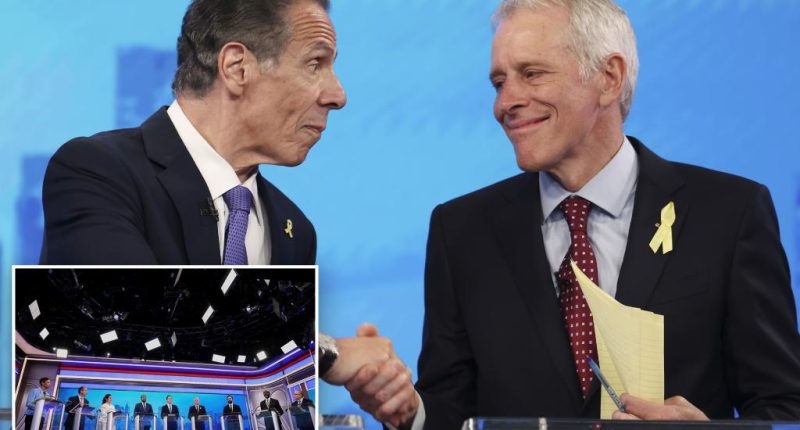Share this @internewscast.com

When it comes to education, the Democratic candidates for mayor deserve a dunce cap and a failing grade, according to a new research study.
A recent report by the Manhattan Institute, titled “Education Agenda for New York City’s Mayor,” suggests a return to strategies from the Mike Bloomberg era. The recommendations include promoting the growth of charter schools, increasing the number of merit-based schools, shutting down and merging underperforming and under-enrolled schools, and implementing accountability tools like issuing report cards that grade each school from A to F based on performance.
The report also advises against the expensive class size reduction law, which could increase the already substantial $40 billion+ budget of the city’s Department of Education. This is significant considering that the current spending is already $33,000 per student, despite a 12% drop in enrollment since before the pandemic in 2019.
However, Ray Domanico, the report’s co-author, noted that most leading Democratic mayoral candidates are not advocating for these measures or featuring them prominently in their campaigns, as mentioned in the report shared with The Post on Wednesday.
“I give the mayoral candidates a D or an F grade across the board,” said Domanico, who wrote the report with fellow researcher Danyela Egorov.
He said the exception was Democratic candidate Whitney Tilson, the hedge fund executive who has embraced many of the ideas in the new report, particularly promoting school choice and accountability and overhauling the class size reduction law. But Tilson is barely registering in the polls.
“Under Bloomberg, education improved considerably, particularly for low income students and students in communities of color. It’s very disappointing that no one wants to accept the undeniable success,” said Damonico, the former director of education research at the city’s Independent Budget Office
The emergence of charter schools is “the biggest educational improvement in the last quarter century,” Damonico added.
About 150,000 or 15% of all NYC public school students attend 281 charter schools across the five boroughs.
Students in charters — publicly funded, mostly non-union, privately managed schools — typically outperform their counterparts in traditional public schools.
But none of the top-tier candidates are urging the state Legislature to lift the cap on charter schools that can open in New York City, not even ex-Gov. and front-runner Andrew Cuomo, who championed charter schools while in the statehouse.
Cuomo instead recommends ramping up “community schools” with wraparound services, a favorite program of the teachers’ union, which Damonico called a bust under former Mayor Bill de Blasio.
Meanwhile, mayoral candidate Zohran Mamdani’s education plan calls for scrapping the mayor’s authority to oversee the Department of Education and set school policy, which critics say weakens accountability in the school system.
Bloomberg’s tenure as mayor from 2002 to 2013 promoted policy changes that emphasized accountability for school performance, support for innovation in both traditional public schools and charter schools sectors, and expanded choice of schools for all students.
“Unfortunately, the success of that reform was deliberately undone during Mayor Bill de Blasio’s
administration,” the report said.
De Blasio fought the expansion of charter schools and eliminated A-to-F school report cards.
“For the last 12 years, New York City’s schools have been on the wrong path, thanks to legislative and executive actions in City Hall and in the state capital,” Egorov and Damonico said in the report.
The authors, however, praised current Mayor Eric Adams for implementing a phonics-based science of reading curriculum — New York Reads — but little else.
There are too many schools with low enrollment that have to be closed or merged with another — 22 schools have fewer than 150 students and 43 have between 151 and 200, the report said.
“It’s unusual to have a school system that loses students, can’t teach our kids and keeps getting more money,” said co-author Egorov, a policy Fellow at 50 CAN, an educational advocacy group and and a parent who is secretary of Community Education Council 2 in Manhattan.
Recent scores on the National Assessment of Educational Progress — known as the nation’s report card — showed just 33% of fourth graders were deemed “proficient” in math, and 28% in reading — below the state and national average. Just 23% of eighth graders were proficient in math, and 29% in reading.
The report recommends increasing seats in merit-based or admissions-based middle schools and high schools — such as Stuyvesant and Bronx School — to attract and retain students in the school system, as well as offer more career-based schools that would connect kids to jobs immediately upon graduation.
In conclusion, the authors argued that the next mayor should push the state Legislature to remove the cap on charter schools, scrap or rework the class size reduction law, reduce the number of members of the Panel for Educational Policy to make it more accountable to the mayor and right-size the unwieldy 32 community school district system.

















